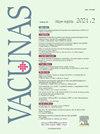人鼻病毒多表位疫苗的合理芯片设计及其免疫模拟和分子动力学模拟方法
Q3 Medicine
引用次数: 0
摘要
鼻病毒(HRV)属于小核糖核酸病毒科肠病毒属,是一种正义单链RNA病毒。通常会引起呼吸道感染,包括普通感冒。目前尚不清楚如何治疗HRV感染。方法采用稳健的免疫信息学技术预测基因组多蛋白上的b细胞、CTL和HTL表位。选择非过敏性和抗原表位是为了生产患者可以接受的亚单位疫苗。结果该疫苗的免疫原性评分为- 4.46838,其抗原比分别为0.5625和0.450999,采用ERRAT、Rampage和ProSa-web服务器对疫苗模型进行验证。因此,z得分为- 6.85,ERRAT得分为90.432,生成的Ramachandran图值为86.0%。当TLR-7与疫苗对接时,发现它与151个非键成分、7个氢键和1个盐桥具有良好的相互作用。利用MD模型对对接物的稳定性进行了评价。反译疫苗的GC含量为48.4%,CAI值为0.99%。为了在潮湿实验室中实现这一概念,将反翻译疫苗序列克隆到pET28a(+)载体上。结论研制的疫苗需经过实验验证,以保证其对该病的防治效果。这项新研究的最终应用将是治疗hrv相关疾病,以及即将进行的实验测试,以验证所建议的疫苗设计的安全性和免疫原性。本文章由计算机程序翻译,如有差异,请以英文原文为准。
Rational in-silico design of a multi-epitope vaccine against human Rhinovirus an immune simulation and molecular dynamics simulation approach
Background
The Rhinovirus (HRV) belongs to the Enterovirus genus in the Picornaviridae family and is a positive-sense single-stranded RNA virus. Commonly accountable for respiratory tract infections, which include common colds. It is yet unknown how to treat HRV infection.
Methods
This study employed robust immunoinformatics techniques to predict the B-cell, CTL, and HTL epitopes on the Genome Polyprotein. Both non-allergic and antigenic epitopes were chosen in order to produce a subunit vaccine that patients could receive.
Results
The vaccine's immunogenicity score was reported as − 4.46838, and its antigenic ratio yielded values of 0.5625 and 0.450999, respectively, using ERRAT, Rampage, and ProSa-web servers to validate the vaccine model. Consequently, the Z-score was − 6.85, the ERRAT score was 90.432, and the Ramachandran plot value was generated as 86.0%. When TLR-7 was utilized to dock the vaccine, it revealed a good interaction with 151 non-bonding components, 7 hydrogen bonds, and 1 salt bridge. Using MD modeling, the stability of the docked complex was assessed. The vaccine had a GC content of 48.4% and a CAI value of 0.99% when it was reverse-translated. To implement the concept in a wet laboratory, the reverse translated vaccine sequence was cloned in pET28a (+) vector.
Conclusion
The vaccine developed in this work has to be experimentally validated in order to ensure its efficacy against the disease. The final application of this new research will be in the treatment of HRV-related illnesses as well as in upcoming experimental testing to verify the safety and immunogenicity of the suggested vaccine design.
求助全文
通过发布文献求助,成功后即可免费获取论文全文。
去求助
来源期刊

Vacunas
Medicine-Infectious Diseases
CiteScore
3.90
自引率
0.00%
发文量
138
审稿时长
62 days
期刊介绍:
Sin duda una de las mejores publicaciones para conocer los avances en el campo de las vacunaciones preventivas, tanto en el ámbito de la investigación básica como aplicada y en la evaluación de programas de vacunaciones. Su alta calidad y utilidad la ha llevado a estar indexada en los prestigiosos índices IME y SCOPUS.
 求助内容:
求助内容: 应助结果提醒方式:
应助结果提醒方式:


